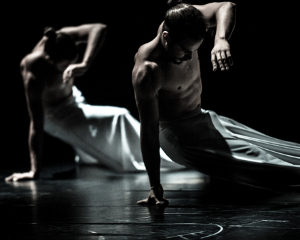In honor of Valentine’s Day weekend the Asheville Symphony Orchestra played a program of pieces related to that amorous event. On the bill were selections from Prokofiev’s Romeo and Juliet, Rachmaninoff’s Vocalise, two movements from William Walton’s score to Henry V, and Mozart’s Piano Concerto No. 21, a piece now remembered for being used in the Swedish film Elvira Madigan.
They began with two movements from William Walton’s score to Shakespeare’s Henry V, “Passacaglia on the Death of Falstaff” and “Touch her soft lips and part,” which were performed with a warm, full sound by the strings. The pieces are simple, yet effective evocations of English history with clear ties to composers like Purcell. “Passacaglia on the Death of Falstaff” is especially reminiscent of the many passacaglias written by that composer.
The concerto on the program was Mozart’s Piano Concerto No. 21 in C, K. 467. The soloist was Dudana Maazmanishvili, a young Georgian pianist. Ms. Maazmanishvili played with the lyricism and grace that Mozart’s music demands, without seeming awkward or contrived. The balance with the orchestra in the second movement was exquisite; the soloist’s melodies rose delicately over the orchestra’s elegant accompaniment. The third movement was played brilliantly and energetically with the soloist playing a lengthy, dazzling cadenza at end of the movement. Unfortunately, the acoustics in the Thomas Wolfe are not conducive to the sound of a small chamber orchestra, for which this concerto is scored. Even the loudest fortes seemed small compared to what they would sound like in a more resonant hall. The audience thoroughly enjoyed the performance, and gave a lengthy standing ovation.
Rachmaninoff’s much-arranged “Vocalise” opened the second half. This arrangement was made by Rachmaninoff for a medium sized orchestra. The piece is always a crowd-pleaser, and this evening’s performance was no exception. The audience responded enthusiastically to that melancholy, wordless melody sung with great passion by the string section.
More Shakespeare rounded out the program with selections of music from Prokofiev’s ballet Romeo and Juliet. Instead of playing one of the three suites that Prokofiev constructed, the symphony played six selections from the first two suites: “Masks,” “Balcony Scene,” “Death of Tybalt,” “Montagues and Capulets,” “The Young Girl Juliet,” and “Romeo at the Tomb of Juliet.” “Death of Tybalt” was the most impressive movement. The strings were very crisp in the long passages with flurries of 16th notes that fill the movement. “Masks” felt earthy and strange. ASO Conductor Daniel Meyer did well in emphasizing the off-kilter harmonies of this syncopated dance. “The Young Girl Juliet” had a playful air about it, and the principal cellist’s solo was sublimely lyrical. Perhaps the best movement in the piece, “Montagues and Capulets,” was played with plenty of bravura in the brass, and the strings performed their angular melodies with a scathing cynicism.
Editor’s Note: We welcome Craig Brinker to the pages of CVNC. He is a member of our internship program at Brevard College.











